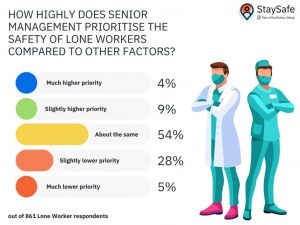
Research from Stay Safe suggest that over 90% of those working at an executive level in health and safety feel they have a good understanding of their legal responsibility surrounding lone working, however, 61% of lone workers do not feel they have a good understanding of lone working safety regulation. This suggests there is a communication issue where messages to employees are not getting through.
In addition to this, employees have a poor understanding of who is to blame if there is an incident involving a lone worker. 51% of employees knew that the company has the ultimate responsibility for their safety.
Lone worker incidents are being significantly underreported
According to Stay Safe only 36% of lone workers have expressed their safety concerns to their employer, but it seems that HSE executives are unaware, with nearly all (92%) believing that their lone workers are speaking to them regularly about any incidents and concerns. This level of underreporting could lead to complacency and ultimately lead to staff underestimating the level of risk they face in the workplace.
So what can be done?
Here are some steps to help enhance communication with staff on lone working practices:
- Establish clear policies and procedures – Develop comprehensive policies outlining lone working practices including safety protocols and emergency procedures.
- Provide thorough training – Offering training sessions covering the risks associated with lone working and methods to mitigate these risks.
- Open channels of communication – Create an environment within your organisation where people feel comfortable discussing issues or concerns related to lone working. Hold regular team meetings, one-to-one discussion, maybe even an anonymous suggestion box.
- Provide psychological support – In addition to the physical risks associated with lone working, it’s important to recognise that there may be a potential psychological impact. Consider offering support services like counselling or employee assistance programs to help staff cope with stress or anxiety related to their work environment.
- Review and update your processes – Putting procedures in place is a great first step, but make sure you are reviewing these processes and using the information you have gathered from regular meetings, suggestions boxes etc, make changes to your procedures.
By taking proactive measures to enhance communication and support, businesses can better protect the well-being of their employees and mitigate the risks associated with lone working.
For more information – Lone workers: how employers should protect them – Overview – HSE
Latest News
Riskex Limited
BizSpace
Linford Forum
18 Rockingham Drive
Milton Keynes
Buckinghamshire
MK14 6LY
What3words reference:
Contact us
Make an enquiry:
Company No. 05174302
VAT No. 844 5092 22



